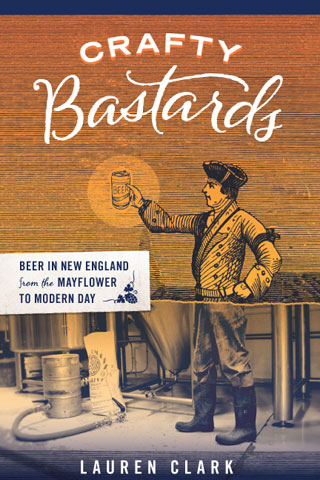January 12th, 2009
 An interview with Misty Kalkofen
An interview with Misty Kalkofen
By MC Slim JB
Boston bartender Misty Kalkofen recently became one of the few bartenders in the country to be certified by the Beverage Alcohol Resource (BAR). If you’re not in the hospitality industry, you can be forgiven for not knowing what a huge deal that is. Think of it as being named a Rhodes Scholar or a MacArthur Fellow for your work with a shaker and your deep understanding of spirits, cocktail culture and history. It takes a lot of training, serious study and the ability to pass a gut-wrenching examination with both lab work and written exercises.
The credential is relatively new. While wine professionals have been able to pursue Master Sommelier diplomas for decades, and chefs their culinary-school degrees for centuries, bartenders have had little to prove their skills other than their following. That changed in 2006, when a group of the industry’s brightest luminaries founded the BAR in New York City to train and certify cocktail professionals. Its faculty features some of the heaviest hitters in the business, including F. Paul Pacult, editor of Spirit Journal; Dale DeGroff, famed mixologist and founder of the Museum of the American Cocktail; Steven Olson, noted wine and spirits writer and educator; Doug Frost, a rare Master Sommelier and Master of Wine; David Wondrich, famed cocktail historian and correspondent for Esquire, and Andy Seymour of aka wine geek.
Ms. Kalkofen took the BAR’s five-day Intermediate course (tuition: $3,500), and by passing the grueling exam received the greater of the two levels of certification, BAR-Ready, which recognizes professional-level bartending skills in high-intensity environments, plus broad knowledge of the culture, history and makeup of spirits and cocktails. (The lesser credential, BAR-Certified, requires more modest bartending skills.) Her resume already reads like a greatest hits of serious Boston bars: she’s currently at Drink, Boston’s newest temple to Golden Age cocktails (her Drink colleague Josey Packard is the only other Boston bartender to be BAR-certified); she previously managed the bar at Green Street, another of Boston’s three or four best; and she’d worked a long stint at the bygone B-Side Lounge, the birthplace of Boston’s cocktail revival. I sat down with her to ask her about her work and her experience with the BAR exam.
MC Slim JB: Was the B-Side your first stint behind the bar?
Misty Kalkofen: Nope. My first bar gig was at the Lizard Lounge. That is also where I met Brother Cleve, who was instrumental in starting me down the road of cocktail lover/historian/geek! He did a weekly DJ night called Saturnalia, and each week he would teach me a classic cocktail recipe. After two years of Thursday nights, I had this nice catalog of delicious classic recipes in my noggin, and I was hooked!
MC: So what was your motivation for taking the BAR exam? Professional pride? Bragging rights with your peers? Career opportunities?
MK: I’d heard a lot about the BAR and had been interested in it for a while. Obviously, all one needs to do is read the bios of the instructors to realize that you will learn soooo much. And in any profession, if you stop learning, you stop growing, and the rest of the industry will pass you by. So the educational side was a huge draw for me. Also, I knew I would meet folks from all over the country who are interested in the same things I am. I love having people to talk to about ideas and trends, so the more bartenders and brand ambassadors I can meet the better!
MC: Tell me about the exam. I’ve heard it’s more stressful than the SATs and GREs combined. What are the different components?
MK: The exam consists of three parts. In the practical phase, they set up a faux bar situation in the kitchen of the Astor Center and took us in six at a time to make drinks. We were evaluated by two people: one instructor and one BAR graduate. They approached us as guests and started ordering drinks. We had to make six drinks, and were evaluated on technique, knowledge and our ability to make the drinks correctly and deliciously in the allotted time.
Part two was the tasting phase. First, we had to blind-taste two variations of the same cocktail and compare them. The point wasn’t to name the drink, but to contrast the two, saying which was more balanced and why. Next, we had to blind-taste six spirits. For each we filled out an evaluation sheet on which we had to list all the aspects of the spirit’s taste, both generally and specifically.
For example, I would mark the box for “tropical fruits,” but I would then need to write down which specific tropical fruits, e.g., coconut or banana. We assessed for fruit, non-fruit (flowers, herbs, spices, vegetables), wood and aging — for example, what notes (such as butterscotch or pepper) hint at barrel aging, what type of wood the spirit was aged in and for how long. We were also asked to estimate proof and to evaluate cleanliness, balance, oak integration, length of finish, complexity and quality. Finally, we had to identify what the spirit was made from, where, and what category it falls into. You could get extra credit for naming brands, a specific region of origin, etc.
Part three was a written exam: about a hundred true/false, multiple choice, short answer and essay questions. Then I had to critique a cocktail menu.
MC: Yikes! So, what drinks did you have to make?
MK: Four were from a list of the most important/common drinks from the manual that we’d been studying. For number five, I had to buy a spirit from Astor Wine and Spirits, make an infusion from it, and then create a cocktail based on the infusion. It could be something I’d worked with before or something new — it was up to me. The final cocktail was my choice. I made my evaluators (Don Lee of New York’s high-craft speakeasy PDT and Willy Shine of the BAR) a Hearst for my chosen cocktail. Interestingly enough, on the night before the exam, at a dinner in Chinatown, I predicted that Don Lee would be one of my evaluators and that I would make him a Hearst. Perhaps I missed my true calling: fortune teller!
MC: How cool! I’m dying to get to PDT. Do you remember the spirits in the blind tasting?
MK: Well, an answer to that would be pure speculation, as we never get a corrected copy of our exam back. The interesting thing about the blind tasting is that you could evaluate a spirit correctly as far as taste descriptors and aging evaluations were concerned and receive many points, while still arriving at the wrong conclusion as far as a spirit family was concerned.
MC: Sounds like my college topology course. What was the scariest part of the exam?
MK: Hmmm … well, making drinks in the practical phase was nerve-wracking because the setup was unfamiliar, and I was making drinks for two people that I have the utmost respect for in this field. But I was most nervous about the blind tasting. Even in an unfamiliar situation I feel confident in my mixing skills, but the finer points of tasting were new to me. Many of the other folks in the course had amazing palates and also had more background in the proper way to taste spirits, so the group tastings could be a bit intimidating and overwhelming.
MC: You’re a well-educated person: you’ve taken your share of other standardized tests. Were you one of those kids that slayed the SATs? Do you remember your scores?
MK: I don’t. I know my parents were psyched by them, but I have no recollection of what they actually were …
MC: Baloney! You’re just being modest, Ms. Smarty-Pants! So, did you come out of the BAR exam thinking, “Pish, I nailed it,” or were you on tenterhooks waiting for the envelope to deliver your fate?
MK: I didn’t breathe for weeks. I was so frickin’ nervous. Even after I found out I passed I didn’t believe it.
MC: How did you celebrate?
MK: I drank a couple big bowls of punch with the ladies of LUPEC [Ladies United for the Preservation of Endangered Cocktails] and our great supporters at Grand at the first LUPEC punch party!
MC: I’ve seen the photos; that one looked like a lulu! Is there a diploma on your wall now, or do they just teach you a secret handshake? Do you get to put extra letters after your name on your business card?
MK: I wish there was a secret handshake — I think I’ll bring that up. As far as the extra letters, I don’t think there is anymore room after the four already there: l.u.s.h.
MC: So does membership have its privilege, like better shifts? Can you ignore [Drink bar manager] John Gertsen’s advice now? Must your colleagues now refer to you as Madame Bartender or Queen of the Stick?
MK: Queen of the Stick — I like that one! Honestly, it just pushes me to stay on top of my game. Colleagues and coworkers come to me with questions because I’ve taken the course and I want to represent well. So I spend a lot of time with my head in the books reviewing materials and learning more!
MC: Any advice for would-be BAR exam takers?
MK: Start testing yourself on spirits. It doesn’t necessarily need to be blind, but taste ingredients outside of cocktails. Unfortunately that’s not something most bartenders frequently do unless they deal with purchasing. And read everything you can get your hands on.
MC: As a longtime fan of your bartending and hospitality skills, let me say thanks for taking the time to talk with me, and congratulations on your remarkable achievement!
MK: My pleasure!
Guest blogger MC Slim JB is a Boston-based writer whose restaurant reviews and food/drink features have appeared in Boston Magazine, the Boston Phoenix, stuff@night, and the Weekly Dig. MC is also a frequent contributor to the restaurant review website Chowhound.
Permalink | 9 Comments | Filed under Bartenders | Tags: MC Slim JB, Misty Kalkofen, mixology course
January 7th, 2009
Has anyone been following the New York Times’ recently launched blog on drinking, Proof? Here’s its mission statement:
“For the past 10,000 years or so, wherever humans have gathered, there has been alcohol. Some never touch the stuff. But most do. It is used to celebrate, commiserate, mourn, remember and, often, to forget. It is different things to different people: libation, anesthetic, emotional crutch, social lubricant, addictive substance, sacred potion, killer or commodity. In ‘Proof,’ contributors consider the charms, powers and dangers of drink, and the role it plays in their lives.”
OK, now read between the lines: “We acknowledge that alcohol is a legal substance consumed by most of the people on earth for reasons too numerous to count. But the Times is not — we repeat, NOT — using this space to promote booze. In fact, we talk about how bad it can be. A lot.”
Actually, I am thrilled that the New York Times has a blog about drinking. As far as I know, the only other prominent newspapers with a regular, substantive space devoted to this topic are the Wall Street Journal (Eric Felten’s “How’s Your Drink?”) and the San Francisco Chronicle. However, with seemingly over half the posts since October devoted to alcoholism and its aftermath, Proof has largely been a solemn read. Even the posts written by active drinkers have been underwhelming. Until Christmas, that is. The NYT brought the excellent Paul Clarke of Cocktail Chronicles into its stable of bloggers, and the man gave us imbibers a nice, shiny gift box of love. Paul talks about his formative drinking years in New York, then being swept up in the classic cocktail movement upon moving to the West Coast, and closes with a survey of improved cocktailing habits in locales across the nation (with a shout-out to Boston).
Also, the Atlantic Monthly has a two-issue-old column on drink. It’s called Drink. And this month, it discusses Drink, the Boston bar. (God, I’m glad I named this blog drinkboston.com.) The column, written by the awesome Wayne Curtis, has the intro: “Our correspondent toasts a growing trend: the return of the classic cocktail.” It’s so adorable when magazines notice a trend three years after it becomes hot. But honestly, I’m thrilled that a publication launched in 1857 — during the first cocktail craze — has come back full circle!
Permalink | 10 Comments | Filed under Booze in the news, Cocktails |
January 4th, 2009
Even though Scott and I have lived pretty much our entire lives in New England, we had never been to the cute ski-resort town of Stowe, VT until this past Christmas-New Year’s holiday. We did all the things one does in Stowe: ski (downhill and cross-country), skate, shop, eat cider donuts and drink lots of local beer, mostly Switchback and Rock Art.
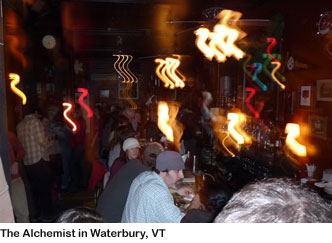
As is the case in most touristy areas of the world, the best (and best-priced) eats and drinks are a bit off the beaten path. In our case, that meant driving to the neighboring town of Waterbury. We arrived at the Alchemist, a brewery-restaurant, on the Sunday after Christmas at around 7 p.m. and were told there’d be an hour-long wait for a table. A good sign, of course, but very bad news for our hungry group. Lo and behold, after our first round of beers, a few seats opened up at the bar.
The Alchemist has a lot of the traits that make Vermont so loveable: a charmingly hippy vibe, local art on the walls, a dedication to using local ingredients, and fresh, well-made beer — some of the best New England beer I’ve had, in fact. The Pappy’s Porter was a nice cross between the English-style brown and robust, roasty versions of this style. The Nightstalker, a Belgian-style dark wit, had a malty complexity on top of the traditional coriander and orange peel flavors, and the Holy Cow IPA was a pleasingly herbal, resin-y hop bomb.
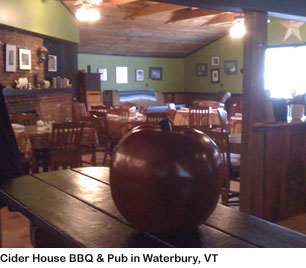
Wandering around looking for lunch on a freakishly warm, rainy day, we stumbled upon another place in Waterbury, the Cider House BBQ & Pub. The establishment, only about a year old, specializes in southern-style cooking and hard cider (on draught and in bottles). Although barbecue aficionados would turn their noses up at the distinctly sweet, New England-type sauce on the ribs and pulled-pork, the food was tasty and, as at the Alchemist, as local as possible. The sides and appetizers — cornbread-and-Andouille-sausage stuffing, Vermont cheddar mac and cheese and, my favorite, fried dill pickle chips — were reason enough to seek the place out. That, and the warm, cozy vibe and sassy waiter, who teasingly anticipated a big tip after hearing that we had splurged on a rental in the heart of Stowe Village.
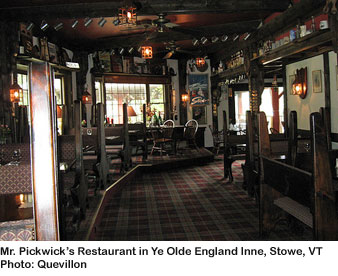
A really good place to drink beer in Stowe has an unfortunately twee name: Ye Olde England Inne. But the inn’s restaurant, Mr. Pickwick’s, is a warm, welcoming homage to an Old World pub, and the draught beer selection includes hard-to-find specimens like Anchor Christmas (both 2007 and 2008 vintages), Belgian abbey ales and a rotating selection of cask ales. The beer-selector and owner, a Brit named Chris Francis, walks around the place unobtrusively checking in on customers and engaging them with a sly sense of humor.

Finally, a shameless but honest plug for one of the best-known places in Stowe, which happens to be managed by my cousin, Brian Clark: the Cliff House. It’s a grand dame of a restaurant perched on a cliff at Stowe Mountain Ski Resort, and you have to take a gondola to get there. Like the Alchemist and the Cider House BBQ & Pub, the Cliff House is part of the local-ingredient-espousing Vermont Fresh Network. It stocks Otter Creek, Magic Hat and other Vermont beers, and serves cocktails made with local maple liqueur. While it’s as pricey as you’d expect a mountain-top restaurant at a major ski resort to be, the range of options includes affordable items like soups, sandwiches and salads, plus you can always just order a drink at the bar. If you happen to be skiing at Stowe, it’s well worth the splurge. Nothing like lunch with a view.
Permalink | 3 Comments | Filed under Beer | Tags: Stowe, Vermont bars
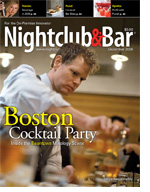 Ever wonder how the Boston mixology scene — the constellation of bars and bartenders who take drink-mixing seriously and are chronicled regularly on this site — came about? Who the originators and other key figures are? What they think of their collective work and its future? Well, you’re in luck, because I lay it all out in a recent cover story for the trade publication Nightclub & Bar. (Yes, that’s Drink‘s own John Gertsen on the cover.) Here’s to all the cocktailians in this city who are helping the scene to thrive!
Ever wonder how the Boston mixology scene — the constellation of bars and bartenders who take drink-mixing seriously and are chronicled regularly on this site — came about? Who the originators and other key figures are? What they think of their collective work and its future? Well, you’re in luck, because I lay it all out in a recent cover story for the trade publication Nightclub & Bar. (Yes, that’s Drink‘s own John Gertsen on the cover.) Here’s to all the cocktailians in this city who are helping the scene to thrive!




